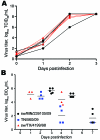Multiple reassortment between pandemic (H1N1) 2009 and endemic influenza viruses in pigs, United States
- PMID: 21892996
- PMCID: PMC3322089
- DOI: 10.3201/eid1709.110338
Multiple reassortment between pandemic (H1N1) 2009 and endemic influenza viruses in pigs, United States
Abstract
As a result of human-to-pig transmission, pandemic influenza A (H1N1) 2009 virus was detected in pigs soon after it emerged in humans. In the United States, this transmission was quickly followed by multiple reassortment between the pandemic virus and endemic swine viruses. Nine reassortant viruses representing 7 genotypes were detected in commercial pig farms in the United States. Field observations suggested that the newly described reassortant viruses did not differ substantially from pandemic (H1N1) 2009 or endemic strains in their ability to cause disease. Comparable growth properties of reassortant and endemic viruses in vitro supported these observations; similarly, a representative reassortant virus replicated in ferrets to the same extent as did pandemic (H1N1) 2009 and endemic swine virus. These novel reassortant viruses highlight the increasing complexity of influenza viruses within pig populations and the frequency at which viral diversification occurs in this ecologically important viral reservoir.
Figures



References
-
- Centers for Disease Control and Prevention. Outbreak of swine-origin influenza A (H1N1) virus infection—Mexico, March–April 2009. MMWR Morb Mortal Wkly Rep. 2009;58:467–70. - PubMed
-
- World Organization for Animal Health. World Animal Health Information Database (WAHID) Interface. Weekly disease information [cited 2010 Jul 14]. http://web.oie.int/wahis/public.php?page=weekly_report_index&admin=0
Publication types
MeSH terms
Grants and funding
LinkOut - more resources
Full Text Sources
Research Materials
